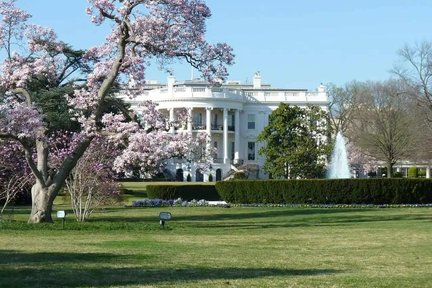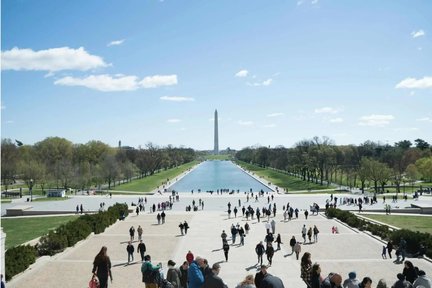Vietnam Veterans Memorial
The best of Vietnam Veterans Memorial
Bucket-list experiences
Make it a getaway
More to explore
Why people love Vietnam Veterans Memorial
Nearby places to go
FAQs about Vietnam Veterans Memorial
Where is the Vietnam Veterans Memorial?
Who designed the Vietnam Veterans Memorial?
The Vietnam Veterans Memorial was designed by Maya Lin, an American architect and artist. Maya Lin's vision and design for the memorial, with its reflective black granite walls bearing the names of the fallen soldiers, have made it a symbol of remembrance and honor for those who served during the Vietnam War.
To find a specific name on the Vietnam Veterans Memorial in Washington DC, you can use the Vietnam Veterans Memorial Fund's online Wall of Faces database. This database allows you to search for names, view their profiles, and locate their names on the memorial. Additionally, physical directories at the site can assist you in locating the names on the memorial's reflective black granite walls. Honoring and remembering a specific individual's sacrifice at the Vietnam Veterans Memorial is a meaningful experience that pays tribute to their service.
What to know before visiting Vietnam Veterans Memorial
What to see at the Vietnam Veterans Memorial
The Wall
Visit the memorable, 'The Wall,' the central feature of the Vietnam Veterans Memorial. This powerful black granite structure, created by Maya Lin, bears the names of 58,318 fallen soldiers, each name a moving tribute to those who sacrificed during the Vietnam War. Strolling along its reflective surface, you'll come close to history, forming a personal bond with the courageous individuals who made the ultimate sacrifice. The names listed in chronological order tell a story of the war, encouraging visitors to contemplate time's passing and the lasting significance of these sacrifices.
Vietnam Women's Memorial
Vietnam Women's Memorial is a powerful tribute to the unsung heroes of the Vietnam War. Dedicated in 1993, this evocative sculpture by Glenna Goodacre honors the more than 265,000 women who served during the Vietnam era. The statue features three women, one tending to a wounded soldier, symbolizing the critical roles women played as nurses, physicians, and support staff. This memorial not only acknowledges their contributions but also highlights the compassion and strength of women in times of conflict, offering a poignant reminder of their vital presence in the war effort.
Three Soldiers Statue
Discover the human face of the Vietnam War at the Three Soldiers Statue, a compelling addition to the Vietnam Veterans Memorial. Revealed on Veterans Day in 1984, this bronze sculpture by Frederick Hart stands near the Memorial Wall, depicting three servicemen from diverse ethnic backgrounds. The 7-foot-tall figures, with their varied patina, stand watch over the wall, honoring those who fought and returned from the war. This statue complements the Wall by providing a tangible representation of the unity and diversity of those who served, offering visitors a deeper understanding of the personal stories behind the names inscribed on the Wall.
The In-Memory Plaque
The "In Memory" plaque, installed in 2004, can be found at the northeast corner of the Three Servicemen statue plaza. This plaque pays tribute to the men and women who served during the Vietnam War and later passed away due to war-related causes. After the war, many Vietnam veterans have died annually from issues like Agent Orange exposure, PTSD/suicide, and cancer, stemming from their service. Their sacrifices are remembered and honored. From 1999 onwards, the Vietnam Veterans Memorial Fund has hosted an In Memory Day ceremony yearly to recognize all those who lost their lives due to the war. This event acknowledges new honorees and everyone listed on the In Memory Honor Roll, ensuring their memory lives on.
The Flagpole
Look out for a tall flagpole at the memorial, featuring the emblems of the five military branches etched at its base. Proudly flying atop the 60-foot pole are the American flag and the P.O.W. M.I.A. banner. This site is a powerful reminder of the bravery and sacrifice of our service members.
Tips for Your Vietnam Veterans Memorial Visit
When is the best time to visit the National World War II Memorial?
The Vietnam Veterans Memorial Wall is open 24/7, but for a more tranquil experience, consider visiting during the early morning or late evening. The lighting at night creates a unique and solemn atmosphere. Spring and fall offer mild weather, making these seasons ideal for a visit.
How to get to the Vietnam Veterans Memorial?
The Vietnam Wall DC, is conveniently accessible via public transportation. You can take the Metro to nearby stations like Foggy Bottom-GWU, or use the DC Circulator bus. Walking or biking around the National Mall is also a great way to explore the area, including its nearby attractions like Lincoln Memorial and Washington Monument.



